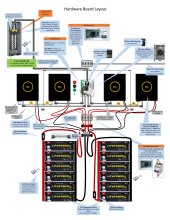For my 4x 120V inverters, I used 2x 2-pole breakers.
Each stacked pair of 120V inverters produced 120/240V split-phase.
At the breaker panel they had one each L1, L2, N, G. Routed in conduit, and at a Tee I used split-bolt splice (wrapped in rubber and vinyl tape) to branch off two N and two G for the two inverters. I had to keep track of which pair, to ensure N carries L1 - L2 current, not L1 + L1 current.
That configuration was done twice for two sets of stacked pairs.
Since your two G, two N, two L has only two "line", I suppose those each split to two inverters paralleled on one phase?
You might do the same for N and G.
I suppose I could run each set of wires from each inverter in separate 1" conduits instead of combining them together before I feed them to the sub-panel. I think that would alleviate the need for derating ampacity.
Yes, that would too.
I think with sufficiently oversize conduit there would be no technical issue (air circulates and heat spread), but letter of the NEC.
If routed in a huge 6x6 box, seems derating is supposed to apply too.
I used 6 awg, could have used 4 awg.
That is uglier though and it’s probably cheaper to go up in wire size. A lot of extra work to avoid multiplying by one factor
But as described it seems like 4 current-carrying conductors for 4 inverters (branched apart later?) and I think can be reduced to 3 current carrying conductors, for no derating.
If excess number in a 2' or shorter length, derating not required. Possibly branch out from first inverter? Daisy-chain?
If you do have just 2 "L", they must be heavy enough for current of two inverters.




